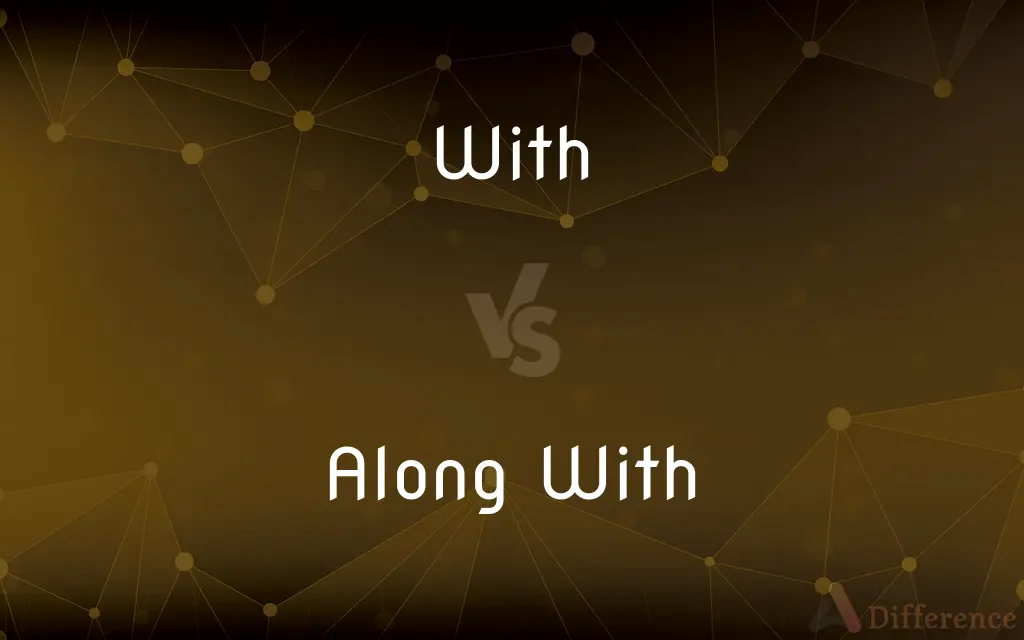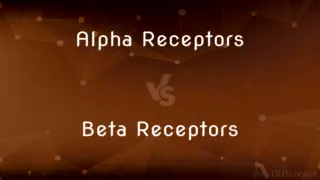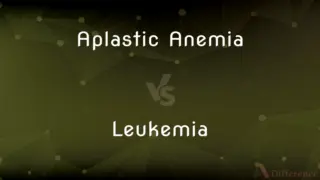With vs. Along With — What's the Difference?
By Tayyaba Rehman — Published on November 10, 2023
"With" indicates association or combination, while "Along With" emphasizes an addition or inclusion, often secondary in importance.

Difference Between With and Along With
Table of Contents
ADVERTISEMENT
Key Differences
The word "With" is a preposition that denotes being together or having something. For example, when someone says, "I'm going on vacation with my family," they mean they're going on vacation and their family will be there too.
"Along With," however, has a slightly different nuance. It typically introduces a secondary or additional element. If someone says, "I'm going on vacation, along with my colleague," the emphasis is on the primary action of going on vacation, with the inclusion of the colleague as an additional piece of information.
Both "With" and "Along With" convey a sense of togetherness, but "Along With" often introduces something supplementary to the main topic or action. Furthermore, "With" is used more broadly and can indicate various relationships or connections, while "Along With" is more specific in highlighting an added component or element.
In grammatical terms, both can be used to link subjects in a sentence, but using "Along With" does not change the number of the main subject.
Comparison Chart
Function
Indicates association or combination
Emphasizes an addition or inclusion, often secondary
ADVERTISEMENT
Frequency
More commonly used
Less frequent than "with"
Grammatical Role
Can link subjects but affects subject-verb agreement
Can link subjects but does not alter subject-verb agreement
Nuance
General togetherness
Introduces a supplementary or secondary element
Flexibility
Has broader uses in various contexts
More specific in emphasizing addition
Compare with Definitions
With
Denotes association or combination.
She attended the party with her friend.
Along With
Suggests inclusion, in addition to.
She brought her notebook along with her pencils.
With
Shows a relation or connection between two things.
The room is filled with chairs.
Along With
Points out an added component.
She loves classical music, along with jazz.
With
In the company of; accompanying
Did you go with her?.
Along With
Emphasizes something additional.
The main course, along with the dessert, was delicious.
With
Next to; alongside of
Stood with the rabbi.
Sat with the family.
Along With
Introduces a secondary element.
He, along with his brother, attended the event.
With
Having as a possession, attribute, or characteristic
Arrived with bad news.
A man with a moustache.
Along With
Highlights something supplementary to the main topic.
We received the report, along with the feedback.
With
Used as a function word to indicate accompanying detail or condition
Just sat there with his mouth open.
A patient with a bad back.
With
In a manner characterized by
Performed with skill.
Spoke with enthusiasm.
With
In the performance, use, or operation of
Had trouble with the car.
With
In the charge or keeping of
Left the cat with the neighbors.
With
In the opinion or estimation of
If it's all right with you.
With
In support of; on the side of
I'm with anyone who wants to help the homeless.
With
Of the same opinion or belief as
He is with us on that issue.
With
In the same group or mixture as; among
Planted onions with the carrots.
With
In the membership or employment of
Plays with a jazz band.
Is with a publishing company.
With
By the means or agency of
Eat with a fork.
Made us laugh with his jokes.
With
By the presence or use of
A pillow stuffed with feathers.
Balloons filled with helium.
With
In spite of
With all her experience, she could not get a job.
With
In the same direction as
Sail with the wind.
Flow with the river.
With
At the same time as
Gets up with the birds.
With
In regard to
We are pleased with her decision. They are disgusted with the status quo.
With
Used as a function word to indicate a party to an action, communicative activity, or informal agreement or settlement
Played with the dog.
Had a talk with the class.
Lives with an aunt.
With
In comparison or contrast to
A car identical with the one her sister just bought.
With
Having received
With her permission, he left. I escaped with just a few bruises.
With
And; plus
My books, with my brother's, make a sizable library. We had turkey with all the trimmings.
With
Inclusive of; including
Comes to $29.95 with postage and handling.
With
In opposition to; against
Wrestling with an opponent.
With
As a result or consequence of
Trembling with fear.
Sick with the flu.
With
So as to be touching or joined to
Coupled the first car with the second.
Linked arms with their partners.
With
So as to be free of or separated from
Parted with her husband.
With
In the course of
We grow older with the hours.
With
In proportion to
Wines that improve with age.
With
In relationship to
At ease with my peers.
With
Being the partner of in a romantic relationship
In April, I will have been with my husband 24 years.
With
As well as; in favorable comparison to
She could sing with the best of them.
With
According to the experience or practice of
With me, it is a question of priorities.
With
Used as a function word to indicate close association
With the advent of the rockets, the Space Age began.
With
As company; along
We're going to the movies. Are you coming with?.
With
Against.
He picked a fight with the class bully.
With
In the company of; alongside, close to; near to.
He went with his friends.
With
In addition to; as an accessory to.
She owns a motorcycle with a sidecar.
With
Used to add supplemental information, especially to indicate simultaneous happening, or immediate succession or consequence.
Jim was listening to Bach with his eyes closed.
The match result was 10-5, with John scoring three goals.
With a heavy sigh, she looked around the empty room.
Four people were injured, with one of them in critical condition.
With their reputation on the line, they decided to fire their PR team.
With
In support of. redundant to be with#English?
We are with you all the way.
With
In regard to.
There are a number of problems with your plan.
What on Earth is wrong with my keyboard?
He was pleased with the outcome.
I'm upset with my father.
With
(obsolete) To denote the accomplishment of cause, means, instrument, etc; – sometimes equivalent to by.
Slain with robbers
With
Using as an instrument; by means of.
Cut with a knife
I water my plants with this watering can. This is the watering can I water my plants with.
Find what you want instantly with our search engine.
They dismissed the meeting with a wave of their hand.
Speak with a confident voice.
With
(obsolete) Using as nourishment; more recently replaced by on.
With
Having, owning.
It was small and bumpy, with a tinge of orange.
With
Affected by (a certain emotion or condition).
Speak with confidence.
He spoke with sadness in his voice.
The sailors were infected with malaria.
With
Prompted by (a certain emotion).
Overcome with happiness
Green with envy; flushed with success
With
In the employment of.
She's was with Acme for twenty years before retiring last fall.
With
Keeping up with; understanding; following along.
That was a lot to explain, are you still with me?
With
(US) Along, together with others, in a group, etc.
Do you want to come with?
With
Alternative form of withe
With
See Withe.
With
With denotes or expresses some situation or relation of nearness, proximity, association, connection, or the like.
With
To denote a close or direct relation of opposition or hostility; - equivalent to against.
Thy servant will . . . fight with this Philistine.
With
To denote association in respect of situation or environment; hence, among; in the company of.
I will buy with you, talk with you, walk with you, and so following; but I will not eat with you, drink with you, nor pray with you.
Pity your own, or pity our estate,Nor twist our fortunes with your sinking fate.
See where on earth the flowery glories lie;With her they flourished, and with her they die.
There is no living with thee nor without thee.
Such arguments had invincible force with those pagan philosophers.
With
To denote a connection of friendship, support, alliance, assistance, countenance, etc.; hence, on the side of.
Fear not, for I am with thee, and will bless thee.
With
To denote the accomplishment of cause, means, instrument, etc; - sometimes equivalent to by.
That with these fowls I be all to-rent.
Thou wilt be like a lover presently,And tire the hearer with a book of words.
[He] entertained a coffeehouse with the following narrative.
With receiving your friends within and amusing them without, you lead a good, pleasant, bustling life of it.
With
To denote association in thought, as for comparison or contrast.
Can blazing carbuncles with her compare.
With
To denote simultaneous happening, or immediate succession or consequence.
With that she told me . . . that she would hide no truth from me.
With her they flourished, and with her they die.
With this he pointed to his face.
With
To denote having as a possession or an appendage; as, the firmament with its stars; a bride with a large fortune.
With
Indicates means or method.
He cut the paper with scissors.
With
Refers to feelings or attitudes towards someone.
She looked at him with surprise.
With
Expresses a certain condition or state.
He's the man with the blue hat.
Common Curiosities
Which is more commonly used, "With" or "Along With"?
"With" is more commonly used.
Is "Along With" more specific than "With"?
Yes, "Along With" often emphasizes an additional or secondary element.
Is the verb form affected when using "Along With"?
No, "Along With" does not alter the verb form based on the secondary subject.
Can "With" indicate means or method?
Yes, e.g., "She wrote with a pen."
What's the primary function of "With"?
"With" indicates association or combination.
Can I always replace "With" with "Along With"?
No, their use depends on context and the emphasis desired.
Is "With" a versatile word in English?
Yes, it has various uses and meanings based on context.
In which scenarios is "Along With" most appropriate?
When introducing something supplementary or secondary to the main topic or action.
Can "With" show a relation between things?
Yes, e.g., "A cup with tea."
Is "Along With" always used between two subjects?
No, it can be used in various contexts to emphasize addition.
How does "Along With" affect emphasis in a sentence?
It emphasizes the addition or inclusion of a secondary element.
Which is longer in terms of word count?
"Along With" is longer than "With."
Does "With" always denote togetherness?
Mostly, but it can also indicate means, method, or state.
Are "With" and "Along With" interchangeable?
Not always; while they can sometimes be used similarly, they often have different emphases.
Can "With" indicate a feeling or attitude?
Yes, e.g., "He spoke with enthusiasm."
Share Your Discovery

Previous Comparison
Alpha Receptors vs. Beta Receptors
Next Comparison
Aplastic Anemia vs. LeukemiaAuthor Spotlight
Written by
Tayyaba RehmanTayyaba Rehman is a distinguished writer, currently serving as a primary contributor to askdifference.com. As a researcher in semantics and etymology, Tayyaba's passion for the complexity of languages and their distinctions has found a perfect home on the platform. Tayyaba delves into the intricacies of language, distinguishing between commonly confused words and phrases, thereby providing clarity for readers worldwide.













































